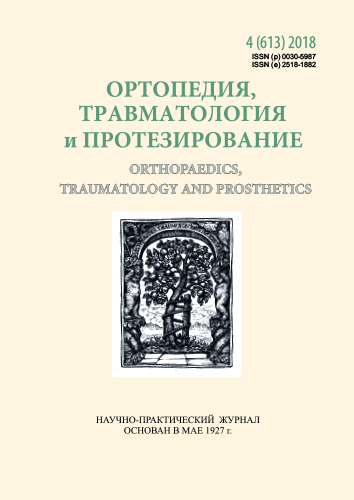Closure of the hip joint capsule defect with a propylene mesh. Clinical and biomechanical research
DOI:
https://doi.org/10.15674/0030-598720184107-114Keywords:
endoprosthesis, hip joint, modeling, biomechanics, polypropyleneAbstract
Dislocation of the femoral component of the endoprosthesis is one of the most common complications after hip total arthroplasty. The best way of prevention is to prevent the development of primary instability. Even with the proper positioning of endoprosthesis components, there are dislocations associated with the weakness or defect of the capsular-connective structures of the joint. Today, a lot of ways have been developed to strengthen and restore the posterior structures of the capsule of the hip joint with the help of auto and allomaterials, differing in the method of fixation and physical and chemical characteristics.
The paper proposes a method of restoring and strengthening the posterior structures of the capsule using polypropylene mesh implants. Objective: to construct a model of the hip
joint capsule after capsulotomy with the help of the specialized software program and to determine the hardness of the defect closed with a polypropylene mesh. Methods: the study was made in a software complex based on the finite element method. A calculation model was constructed consisting of capsule and endoprosthesis femoral head. Two methods of sewing the dissected capsule were studied: seam thread and polypropylene mesh. In the control model, the capsule was not fixed. Results: pictures of the distribution of stress-strain state in the system «endoprosthesis – joint capsule» were obtained. Conclusions: under
the conditions of the kinematic loading of the model, the smallest sizes of the capsule cut opening are in case of its closure with the mesh. In the case of thread, they were 8.5 % higher. The values of equivalent stresses in the model with the mesh were the largest: in the capsule of the joint by 23.8 %, the endoprosthesis head — by 60.4 % compared with the thread fixation. The obtained results indicate that the mesh model is more rigid.
References
- Sanchez-Sotelo, J., & Berry, D. J. (2001). Epidemiology of instability after total hip replacement. Orthopedic Clinics of North America, 32 (4), 543–552. doi:https://doi.org/10.1016/s0030-5898(05)70225-x
- Kwon, M. S., Kuskowski, M., Mulhall, K. J., Macaulay, W., Brown, T. E., & Saleh, K. J. (2006). Does surgical approach affect total hip arthroplasty dislocation rates? Clinical Orthopaedics and Related Research, 447, 34–38. doi:https://doi.org/10.1097/01.blo.0000218746.84494.df
- Browne, J. A., & Pagnano, M. W. (2011). Surgical technique: a simple soft-tissue-only repair of the capsule and external rotators in posterior-approach THA. Clinical Orthopaedics and Related Research, 470 (2), 511–515. doi:https://doi.org/10.1007/s11999-011-2113-6
- Singh, B., Brown, T. D., Callaghan, J. J., & Yack, H. J. (2013). Abdomen-thigh contact during forward reaching tasks in obese individuals. Journal of Applied Biomechanics, 29 (5), 517–524. doi:https://doi.org/10.1123/jab.29.5.517
- Kim, Y. S., Kwon, S. Y., Sun, D. H., Han, S. K., & Maloney, W. J. (2008). Modified posterior approach to total hip arthroplasty to enhance joint stability. Clinical Orthopaedics and Related Research, 466(2), 294-299. doi:https://doi.org/10.1007/s11999-007-0056-8
- Yamaguchi, T., Naito, M., Asayama, I., Kambe, T., Fujisawa, M., & Ishiko, T. (2003). The effect of posterolateral reconstruction on range of motion and muscle strength in total hip arthroplasty. The Journal of Arthroplasty, 18 (3), 347–351. doi:https://doi.org/10.1054/arth.2003.50060
- Menschikova, T. I., Chegurov, O. K., & Menshikov, I. N. (2017). The use of the ultrasound method for assessing the structural condition of the hip joint in patients with different stages of coxarthrosis. International Journal of Applied and Fundamental Research, 1–1, 42–46. (in Russian)
- Tsikandylakis, G., Mohaddes, M., Cnudde, P., Eskelinen, A., Kаrrholm, J., & Rolfson, O. (2018). Head size in primary total hip arthroplasty. EFORT Open Reviews, 21, 3(5), 225–231. doi: https://doi.org/10.1302/2058-5241.3.170061.
- Chizhov, D. V. (2016). Polypropylene materials in surgery of hernia of the abdominal wall (experimental and clinical study) (Doctoral dissertation). (in Russian)
- Rathi, P., Pereira, G. C., Giordani, M., & Di Cesare, P. E. (2013). The pros and cons of using larger femoral heads in total hip arthroplasty. The American Journal of Orthopedics, 42 (8), E53–59.
- Elkins, J. M. (2013). Biomechanics of failure modalities in total hip arthroplasty. doi:https://doi.org/10.17077/etd.addybua3
Downloads
How to Cite
Issue
Section
License
Copyright (c) 2019 Sergey Maslennikov, Sergey Panchenko, Maksim Golovakha

This work is licensed under a Creative Commons Attribution 4.0 International License.
The authors retain the right of authorship of their manuscript and pass the journal the right of the first publication of this article, which automatically become available from the date of publication under the terms of Creative Commons Attribution License, which allows others to freely distribute the published manuscript with mandatory linking to authors of the original research and the first publication of this one in this journal.
Authors have the right to enter into a separate supplemental agreement on the additional non-exclusive distribution of manuscript in the form in which it was published by the journal (i.e. to put work in electronic storage of an institution or publish as a part of the book) while maintaining the reference to the first publication of the manuscript in this journal.
The editorial policy of the journal allows authors and encourages manuscript accommodation online (i.e. in storage of an institution or on the personal websites) as before submission of the manuscript to the editorial office, and during its editorial processing because it contributes to productive scientific discussion and positively affects the efficiency and dynamics of the published manuscript citation (see The Effect of Open Access).














